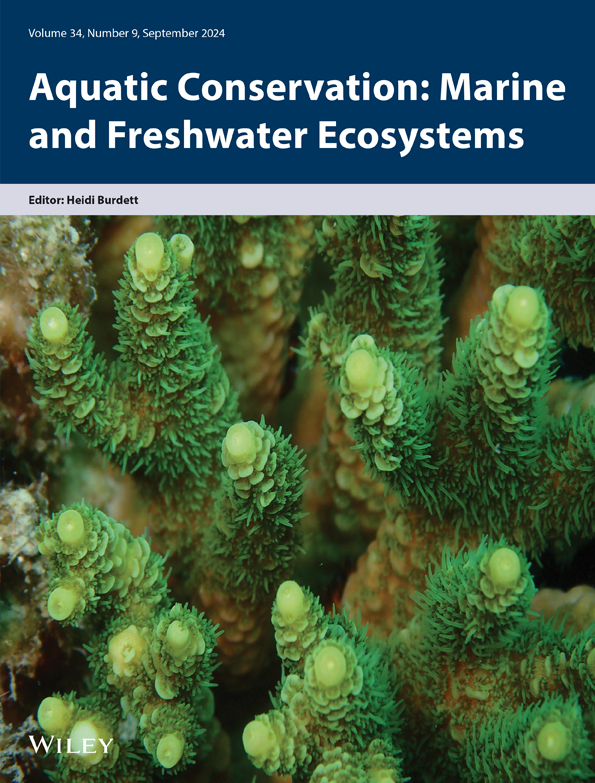Site Selection Criteria and Recommendations for the Restocking of Juveniles of River Prawn Cryphiops caementarius in the Semiarid Region of Chile: A Basin and Participatory Approach
Funding: This work was supported by the Grant ‘Consolidation Program of the Aquaculture Fisheries Strategy of the river prawn Cryphiops caementarius in the Choapa River basin’ funded by the Regional Government of Coquimbo, Chile (Code BIP: 30480241-0).
ABSTRACT
The fishery of the river prawn Cryphiops caementarius in semiarid basins of northern Chile constitutes a small-scale artisanal activity, developed in fragmented habitats with extended periods of drought, which represents a severe threat for the conservation of its populations. Fishers filed an environmental complaint for massive prawn mortalities caused by river channellings in the Choapa River basin. The government promoted a participatory program with fishers to carry out a restocking initiative in this basin, releasing ~4000 hatchery reared juveniles. The aim of this study was to evaluate site selection criteria for the releases, which included ecological variables relevant to the life habits of juveniles. These criteria incorporated background of the natural history of the species, seasonal monitoring of habitat indicators (fluvial habitat index and hydraulic stress index) and recommendations of fishers (traditional ecological knowledge). This study demonstrated that the integration of these criteria and restocking sciences based on aquaculture is beneficial when selecting the release site, with a high coincidence of ecological characteristics for C. caementarius to thrive. The results of this experience are discussed, emphasizing the pioneering character of this type of measure in freshwater crustaceans in Chilean basins, the ecological framework used to responsibly assist these measures in basins with intense anthropogenic impacts and recommendations that allow the improvement of the releases and monitoring efforts of this species, considering the drought scenario that affects this region of Chile.
1 Introduction
The river prawn Cryphiops caementarius is a palaemonid native to the arid and semiarid basins of northern Chile (Figure 1a). In these places, their populations support a small-scale artisanal fishery carried out by communities of local fishers, whose extraction is done manually, with or without the use of fishing gear (Bahamonde and Vila 1971). From an environmental and ecological perspective, this fishery is defined by biophysical conditions (e.g., hydrological regime and diversity of benthic habitats) (Velásquez et al. 2022a), anthropogenic interventions (e.g., river channellings and reservoirs) (Velásquez, Alanís, and Cárcamo 2022), river trophic structure (e.g., predator guilds) (Velásquez et al. 2020), the ecological attributes of the species (omnivorous, opportunistic and cannibalistic behaviour of adults towards juveniles) and the spatial segregation of the ontogenic stages (adults, juveniles and larvae) in the different limnetic zones of the basin (fluvial habitat: rhithron and potamon; estuarine habitat: river mouth) (Velásquez et al. 2022b). In general, the adult fraction is concentrated in the rhithronic zone of the basin, which is characterized by its steep slope, turbulent flows and boulder substrate. Juveniles occur preferentially in the potamic and rhithron/potamon transition zones, where the slope descends, and are characterized by laminar flows. Finally, the larval stages develop in the estuarine zone at the mouth of the rivers (Velásquez et al. 2022b) (Figure 1a). This spatial segregation reflects the amphidromous migratory behaviour of C. caementarius, where mating occurs in fluvial habitats and the ovigerous females migrate downstream to estuarine habitats during spring and summer. Eggs hatch and larvae develop in the estuarine habitat and juveniles return upstream to complete their adult life cycle (Bahamonde and Vila 1971).
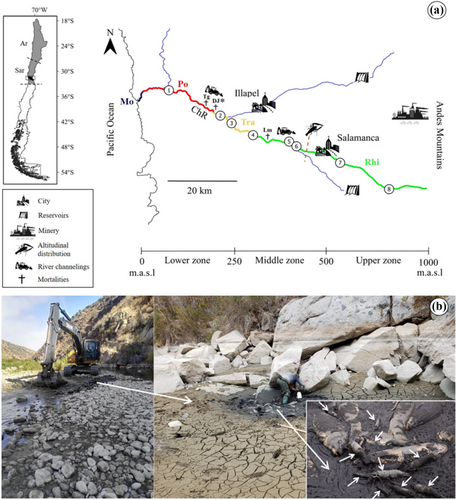
During the last decade, their populations have been subjected to intense extractive pressure for human consumption (mainly for local restaurants, for which sales prices can fluctuate between 13 and 20 USD kg−1) without restriction of minimum extraction sizes (≤ 30 mm of cephalothorax length) or the protection of ovigerous females (Velásquez et al. 2022a). Furthermore, the fisheries for this species take place in highly fragmented habitats undergoing overexploitation of water resources and during extended periods of drought, which constitutes a severe threat to the conservation of C. caementarius (Velásquez, Alanís, and Cárcamo 2022). Accordingly, in 2013, the Chilean Ministry of Environment (MMA) included C. caementarius in the Vulnerable (VU) category, which means that it is a threatened species with a high probability of extinction in the wild. Among the most relevant risk factors for its conservation are river channellings, these channels direct the flow and volume of water into a section of the river to achieve continuous and homogeneous flow through the intervention of the river morphology (e.g., elimination of meanders) via heavy machinery (Figure 1b) (Velásquez et al. 2023). The purpose of this interventions is to supply water for human consumption and whose demand has intensified during the last decade as a product of the droughts (Álamos et al. 2024). This type of intervention directly impacts aquatic biodiversity, causing mortality, which has been reported for several semiarid basins of Chile, being one of the most affected, that of the Choapa River (Velásquez, Alanís, and Cárcamo 2022) (Figure 1b).
In August 2014, fishers from the Choapa River basin filed a complaint with regional authorities regarding the massive mortality of C. caementarius individuals caused by river channellings at the locality of Doña Juana (Figure 1a), the same place where hatchery-reared juveniles were released in 2012 (UCN 2013). As a compensatory measure, the authorities promoted a restocking programme for C. caementarius in the Choapa River basin together with the affected fishers (IFOP 2022), including as a main milestone, the hatchery production of ~4000 juvenile individuals for restocking the river (UCN 2021). To increase likelihood of success of these releases, it was necessary to develop site selection criteria that included the biophysical variables related to the life habits of this species considering the limnetic attributes of the different zones of the basin.
The site selection criteria applied in this study used a basin-integrated approach including co-participative planning and execution process with the fishers, framed with international guidelines for a responsible approach for restoration and restocking initiatives to increase the success of these actions (Lorenzen, Leber, and Blankenship 2010; Lorenzen et al. 2021). The aim study was to select site(s) for the restocking of juveniles of C. caementarius in the Choapa River basin, through the incorporation of criteria derived from scientific knowledge (background of the natural history of C. caementarius in the basin), seasonal monitoring of habitat indicators (fluvial habitat index and hydraulic stress index) and traditional ecological knowledge (recommendations of the fishers). The results of this experience are discussed based on the pioneering character of this type of measure in freshwater crustaceans in Chilean basins, the ecological framework used to responsibly assist these measures (i.e., site selection criteria and scientific and traditional ecological knowledge) in basins with intense anthropogenic impacts and recommendations that allow the improvement of releasing and monitoring of the species, considering the drought scenario in this region of the country.
2 Natural History of C. caementarius in the Choapa River Basin
The altitudinal distribution of C. caementarius in the basin is limited by reservoirs, river channellings and areas of aggregates extraction (e.g., gravel and sand) along the river. These anthropogenic interventions restrict populations to the lower and middle zones of the basin up to ~400 m above sea level (m.a.s.l.) (Figure 1a) (Velásquez et al. 2022a). In these zones, habitat suitability is determined by the diversity of benthic habitats (e.g., riffles, pools and riversides), whose functioning is determined by the flow velocity and depth or water and the availability of refuges, such as aquatic macrophytes, submerged roots of riparian vegetation and boulders substrates, which are used as feeding and reproduction sites (Figure 2) (Velásquez et al. 2022b, 2023). The combination of these variables determines the heterogeneous distribution of the population, with adults concentrated mainly on the central river axis and juveniles concentrating on the riversides (Figure 2). Throughout this basin, C. caementarius is preyed upon by carnivorous waterfowl (herons, egrets, cormorants and seagulls), the Chilean giant frog (Calyptocephalella gayi), exotic invasive fishes (Oncorhynchus mykiss and Cyprinus carpio) and native fishes (Basilichthys microlepidotus and Mugil cephalus), whose predation pressure differs depending on the ontogenetic stage of C. caementarius and the limnetic zone (Velásquez et al. 2020). Regarding the massive mortality of prawns associated with river channellings, Velásquez, Alanís, and Cárcamo (2022) reported three sectors: Doña Juana (August 2014), Tunga Norte (March 2020) and Limahuida (January 2021) (Figure 1a).
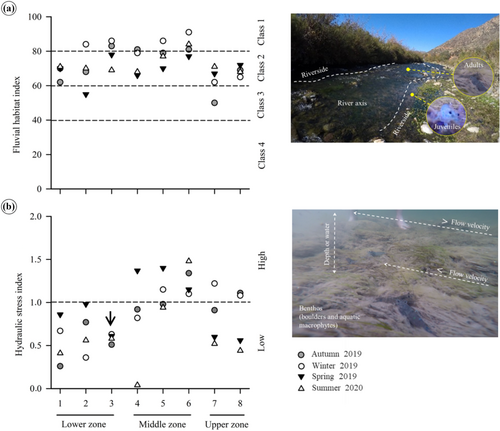
3 Characterization of Habitat Suitability for C. caementarius
3.1 Sampling Sites and Environmental Monitory
The Choapa River basin (~32° S) is in the semiarid region of Chile (Figure 1a), receiving pluvial and snow water contributions (mixed regime), with hydroperiods strongly influenced by prolonged droughts during summer and autumn, and a period of precipitation concentrated in winter (Sarricolea, Herrera-Ossandon, and Meseguer-Ruiz 2017). The study was carried out at eight sampling sites stratified altitudinally in the lower (Sites 1, 2 and 3; ~0–250 m.a.s.l.), middle (Sites 4, 5 and 6; ~250–500 m.a.s.l.) and upper (Sites 7 and 8; ~500–1.000 m.a.s.l.) zones (Figure 1a) during autumn (April 2019), winter (July 2019), spring (October 2019) and summer (January 2020). Each sampling site was in a different limnetic zone of the basin (rhithron, rhithron/potamon transition and potamon) (Figure 1a) and consisted in transects of ~50 m in length parallel to the river, thus covering sections of representative benthic habitats of the river. At each site, the fluvial habitat index (FHI) and the hydraulic stress index (HSI) were estimated. The FHI and HSI are defined below.
3.2 FHI
This index evaluates the capacity of the semiarid and mediterranean rivers to host aquatic biota through the assignment of scores of seven biophysical variables (Palma, Figueroa, and Ruíz 2009; Pardo et al. 2002; Velásquez et al. 2023), which include the variables relevant to the life habits of C. caementarius (see Section 2): (a) inclusion of riffles and pools (maximum 10 points), (b) frequency of riffles (maximum 10 points), (c) composition of the substrate (maximum 20 points), (d) depth or water and flow velocity (maximum 10 points), (e) percentage of shade in the channel (maximum 10 points), (f) elements of heterogeneity (maximum 10 points) and (g) coverage of aquatic macrophytes (maximum 30 points). The total sum of the variable scores can fluctuate between 0 and 100. These scores are classified into four categories based on their ranges: Class I (100–81; very good/heterogeneous), Class II (80–61; good/relatively heterogeneous), Class III (60–41; regular/homogeneous) and Class IV (40–0; bad/very homogeneous). The application of this index indicated three categories of FHI (I, II and III classes; Figure 2a). In spatial terms, eight sites were Class II, five sites were Class I, and two sites were Class III. Regarding the temporal variation in the FHI per site, fluctuations were observed at 75% of the sites, except for Sites 1 and 8, which showed relatively stable FHI over time. These fluctuations were related to seasonal differences, with autumn 2019 being the year with the greatest variation in the FHI, contrasting with winter and spring 2019 and summer 2020. The category that had the greatest spatial and temporal stability was Class II, which represented 87.5% of the total sites during the spring 2019 and summer 2020 seasons (Figure 2a).
3.3 HSI
At each sampling site (i.e., transects of ~50 m in length parallel to the river), three different types of benthic habitats (i.e., riffles, pools and riversides) were selected to represent the heterogeneity of the site. For each habitat, the total depth or water (cm) and the flow velocity (m s−1) were estimated. From these data, the Froude number (FROU) was calculated, where FROU = U/(g D)0.5, U = average of flow velocity, g = gravitational force (9.8 m s−2) and D = average of depth water (Statzner, Gore, and Resh 1988). These values fluctuate between zero and two; that is, sites with high values (over one) correspond to turbulent and/or higher flow areas, which implies greater stress for juvenile prawn individuals (Velásquez et al. 2022b). The application of this index indicated ranges of HSI values between 0.26 and 1.48, separated into two groups: sites with low HSI (< 1) and sites with high HSI (> 1) (Figure 2b). In spatial terms, seven sites presented HSI < 1, and five sites > 1. Regarding the temporal variation by site, fluctuations were observed at 50% of the sites (Sites 4, 5, 7 and 8), whereas the remaining 50% were relatively stable over time (Sites 1, 2, 3 and 6). These fluctuations are related to the time of year, with summer 2020 being the year with the least variation in the range of HSI, in contrast to the winter season 2019, which presented the greatest variation. The range of HSI that had the greatest spatial and temporal stability in the river was < 1, representing between 62.5% and 87.5% of the total sites during the autumn and spring 2019 and summer 2020 seasons (Figure 2b).
4 What Do Fishers Recommend Us?
Traditional ecological knowledge (TEK) was collected through the application of semi-structured interviews to qualified informants (N = 17) during March 2019. Fishers with more than 10 years of experience in the activity were considered qualified informants. The age of the interviewees varied between 29 and 65 years old (six women; 11 men). The questions were oriented towards ecological aspects of C. caementarius juveniles and release strategies in the basin. The responses were indicated according to the group representativeness of the discourse (Table 1). In summary, they suggest releasing juveniles during dusk hours in the lower and middle zones of the basin between spring and summer, choosing locations free of river channellings and with low salmonid presence, particularly along the riverside (away from riffle areas) and abundant in refuges (Table 1).
| Questions | Responses |
|---|---|
| What are the main predators of juveniles and what escape behaviour do they present? | The main predators of juvenile prawns were carnivorous waterfowl, such as herons, and exotic invasive fish, such as carp and salmonids; the latter had greater occurrence in the upper area of the basin. The escape behaviour of juveniles consists of taking refuge during the day among boulders and muddy areas, aquatic macrophytes, submerged roots of ‘chilca’ plants (Baccharis spp.) and logs present on the river |
| What are the main anthropogenic threats to the survival of juveniles? | Juvenile prawns are affected by permanent drought in the basin; aggregate extraction; river channellings; illegal extraction of river water; reservoirs; illegal fishing of prawn juveniles for local consumption |
| What sites and times of year is suggested for releasing juveniles in the basin? | The release should be carried out during dusk hours in the lower and middle zones of the basin between the months of October and February (spring and summer seasons) |
| What do you recommend for good management of the release of juveniles? | For a good management in releasing juveniles, they must be previously acclimatized to the external conditions of the river and must be released in places free of river channellings and low presence of salmonids, specifically in the riverside (away from riffles areas) and with a wide presence of refuges |
5 Site Selection Criteria and Recommendations
The selected sites for the release of juveniles were evaluated through the incorporation of six criteria relevant to the life habits of the juveniles and their release into the river, derived from the background knowledge of the natural history of C. caementarius in the basin, FHI, HSI and TEK (Table 2). For each sampling site, a total score was obtained, derived from the sum of the criteria met, whose range fluctuates with a minimum of one point and a maximum of six points. Sites with a score range between 1 and 3 do not meet the requirements for restocking actions, sites with a score of 4 are acceptable, and sites with a score range between 5e and 6 represent optimal conditions for restocking. Due to the similarity in the scores of the sampling sites, the basin was separated into three zones (lower, middle and upper). The sites located in the lower zone meet 83.3% of the criteria, reaching a total score of 5, indicating optimal condition for restocking. The sites located in the middle zone meet 50% of the criteria, resulting in a total score of 3, whereas the sites located in the upper zone meet 16.6% of the criteria, yielding a total score of 1; both zones did not meet the requirements for restocking actions (Figure 3).
| Criterion | Description | Score | Recommendations |
|---|---|---|---|
| Criterion A. Habitat quality | This criterion evaluates the heterogeneity of the benthic habitat through the application of the FHI. It is very important that sites have good habitability and availability of refuges | 1 | All evaluated sites exhibited good habitat conditions and heterogeneity (Classes I and II). Under this criterion, all sites are suitable for the release of juveniles, but due to their spatial and temporal stability, Class II sites are recommended for the spring season |
| Criterion B. Hydraulic conditions | This criterion evaluates the hydraulic fluctuations in a river through the application of the HSI. It is very important that sites have a permanent water supply over time without abrupt fluctuations. This approach is relevant considering the extended droughts in the basin | 1 | The sites at the lower zone of the basin have lower values of HSI (< 1) than those in the middle and upper zones. Under this criterion, the release of juveniles is recommended at sites in the lower zone, particularly Site 3, which shows little seasonal variation in HSI values and a permanent water supply over time |
| Criterion C. Predators | This criterion evaluates guilds of native and invasive exotic predators present in the river. Under this criterion, sites must have wide access to refuges that reduce the risk of predation. Sites with the occurrence of invasive exotic species, such as salmonids and carps, is not recommended | 1 | Sites with wide availability of refuges are recommended to avoid predation by herons. Sites with salmonids are not recommended, especially in the upper zone of the basin, an area that, according to fishers, has a wide occurrence of these fish. Under this criterion, the sites in the lower and middle zones of the basin are recommended for the release of juveniles |
| Criterion D. Anthropogenic interventions | This criterion evaluates the historic river channellings in the basin. Sites where channellings is continuously carried out and where there is a history of prawn mortality are not recommended | 1 | It is recommended to avoid sectors of the river that are continually channelled, which, as indicated by the fishers, occurs throughout the basin. Under this criterion, sectors with a history of prawn mortality are not candidates for the release of juveniles |
| Criterion E. Release recommendations | This criterion considers the site(s) recommended by fishers for the release of juvenile's prawns and is based on their TEK | 1 | Fishers recommend that the release of prawns be carried out at sites free of channellings and with a low presence of salmonids, specifically on riversides with aquatic macrophytes and riparian vegetation, away from turbulent areas such as riffles. Under this criterion, the sites in the lower zone of the basin are recommended for the release of juveniles |
| Criterion F. Origin of spawners | This criterion considers the area(s) of origin of the parent adults (ovigerous females) used to produce juveniles in hatchery that will be released into the river. This approach was used to protect the genetic and sanitary heritage of the receiving populations | 1 | Ovigerous parental females used in hatchery came from the lower zone of the basin; therefore, for the genetic and sanitary protection of the receiving populations, it is recommended that prawns be released in the same zone |
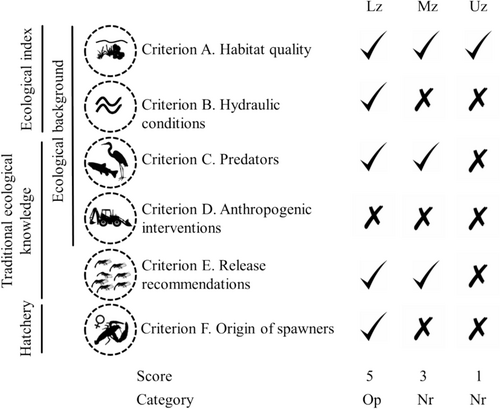
6 Where and How Were the Juveniles Released?
Based on the criteria recommendations, ~4000 juvenile individuals (~10 mm CL; marked with elastomers) were released in spring (October 2020) on the riverside at dusk at Site 3 in the lower zone of the basin (see Figure 1a). The river course at site corresponds to the rhithron/potamon transition type, characterized by areas of meanders and channels, constant laminar flow, heterogeneity of benthic habitat and availability of refuges and a low presence of salmonids. The release was carried out with the fishers according to the protocol established by UCN (2021), which consists of five stages: packaging, transportation, opening, acclimatization and release (Figure 4). In the packaging stage, the individuals are stored in plastic bags filled with freshwater saturated with oxygen. Subsequently, the bags were transported to the release site within 5 h. Before being released to avoid physiological stress, individuals were acclimatized to the ambient temperature of the river for ~30 min (Figure 4a). Once acclimatized, the individuals were released through gradual immersion of the bag underwater (Figure 4b) in different locations along ~500 m of the riverside (Figure 4).
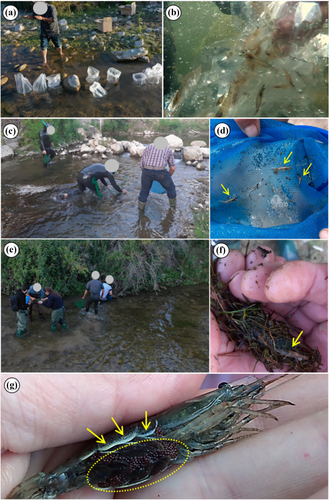
7 Discussion
During the last three decades, 204 restocking actions have been carried out in Chile, with less than 1% of freshwater species (Cárcamo et al. 2021) comprising only two freshwater native species of crustaceans: the river prawn C. caementarius in the Choapa River (northern Chile) (UCN 2013) and the freshwater crayfish Samastacus spinifrons in the Maullín River (southern Chile) (Rudolph, Retamal, and Martínez 2010). In both cases, the indicator of success was the number of individuals released into the river, with little attention to establishing criteria to select appropriate sites. The study demonstrates the development and implementation of a systematic approach to identifying release habitats and strategies based on ecological criteria including TEK. The ecological indicators estimated in this study proved to be adequate proxy for critical biophysical variables necessary for the release of juveniles. The FHI allowed us to evidence suitable habitability conditions and spatial heterogeneity along the Choapa River basin, which can explain the persistence of the populations and the fishery in a highly disturbed basin. On the other hand, considering the mixed semiarid regime with periods of drought in this basin, the HSI was more precise in determining releasing sites and spots within the course of stable water; therefore, this approach is recommended for future use.
The C. caementarius fishery represents an important component of the ancestral and cultural identity of the riverine communities of northern Chile (Jara 1997). Therefore, the recognition of TEK of fishers represents a key input in the development of participative and co-management approach for this species. The experience developed in the Choapa River basin demonstrated that the integration of TEK and restocking sciences based on aquaculture is beneficial when selecting the release site, with a high coincidence of ecological characteristics for C. caementarius to thrive. In Chile, research into the life cycle of C. caementarius in controlled environments has been ongoing for over 20 years. This has made feasible the production of viable hatchery-reared juveniles (Moreno-Reyes, Morales, and Meruane 2021). However, for restocking actions based on aquaculture, the incorporation of multidimensional basin information for intervention should be considered. This approach allows establishing appropriate selection criteria for site selection according to hydrographic and environmental attributes of the receiving basin (arid or semiarid), the life cycle of C. caementarius (amphidromy) and the natural history of local prawn populations (status of conservation).
Due to the short 24-month funding period, the study did not include post-release monitoring to assess hatchery-reared juvenile persistence. However, it is important to highlight that since the releases, the fishers found three marked ovigerous females from the hatchery (Day 60 = 1; Day 90 = 1; Day 120 = 1) at the same site, showing the white line on the periphery of the abdominal segments—an unequivocal indicator of sexual maturity (Figure 4g). For an effective evaluation of fishing productivity, conservation and sustainability of this type of measures, it is recommended that financing of programmes consider medium to long-term post-release monitoring plans. To effectively monitor the reproductive cycle of C. caementarius, a monthly monitoring plan should be implemented for at least a year. This plan should cover a spatial scale of several kilometres upstream and downstream from the release site. Additionally, it is important to consider the habits of the juveniles and to involve qualified fishers who can assist in monitoring activities. These factors are critical in increasing the effectiveness of future monitoring programmes (Velásquez et al. 2023).
The evidence and gaps detected in the present study highlight the importance and need to investigate and develop optimal strategies that allow reinforcing the effectiveness of C. caementarius restocking initiatives in northern Chile, such as (a) to identify and protect river sections less susceptible to be affected by droughts (thus providing greater resilience to the prawn receiving areas), (b) to carry out or perform realize ecological modelling of the biophysical variables that are related to the life habits of C. caementarius considering the limnetic attributes of the different zones of the basin (these approaches will help us understand and simulate the potential ecological scenarios that interacts with the C. caementarius) and (c) post-release survival estimates (to evaluate appropriately the persistence of the hatchery-reared individuals).
From an international perspective, most of the actions involving the release of freshwater crustaceans (shrimps, prawns and crayfish) have been carried out in temperate and tropical ecosystems (e.g., Davenport et al. 1999; Loneragan et al. 2006; Maidin et al. 2017; Whiterod and Zukowsky 2019), with the present study being one of the few documented cases for semiarid ecosystems (e.g., Valencia-Yauli 1999), which is why the ecological criteria and the incorporation of TEK used in this study constitute a new guideline for a responsible approach to restocking river prawns in semiarid basins. This framework is also applicable to other species of amphidromous palaemonids and provides a basis for selecting sites for future conservation and restocking initiatives for freshwater crustaceans in basins with intense anthropogenic impacts.
Author Contributions
Carlos Velásquez: writing – original draft, data analysis, writing – review and editing. Yeriko Alanís: data analysis, investigation. Luis Henríquez-Antipa: conceptualization, writing – review. P. Francisco Cárcamo: writing – review, editing, supervision.
Acknowledgements
We thank the fishers from Choapa Province for their support in the restocking and MC Morales from the Crustacean Culture Laboratory, Universidad Católica del Norte (UCN), by the production of juveniles in hatchery.
Ethics Statement
This research was authorized by the external resolutions (N°3674; N°13,847), Undersecretary of Fisheries and Aquaculture of Chile (SUBPESCA).
Conflicts of Interest
The authors declare no conflicts of interest.
Open Research
Data Availability Statement
The authors confirm that the data supporting the findings of this study are available within the article and the Supporting Information.



